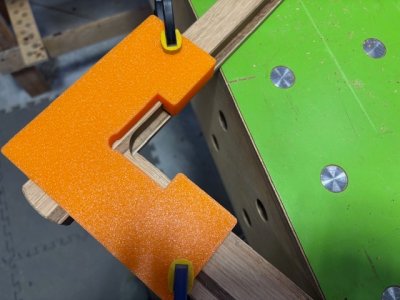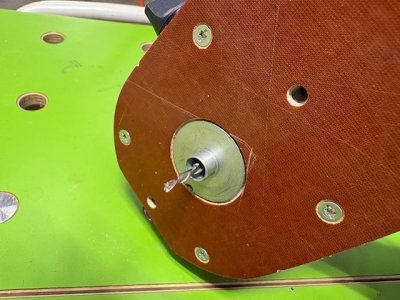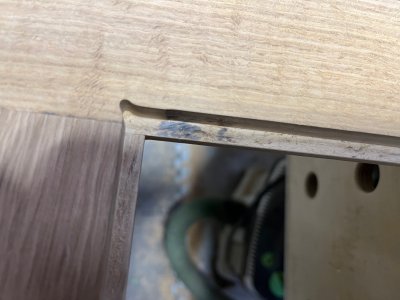luvmytoolz
Member
Something that is super easy to do. And especially with commercially bought templates... they are just CNC routed anyway. Or injection molded, or whatever. And then you still end up that one tiny mistake in your case destroys the template, something that is rather hard to do when using a bushingIn one case, the template is straight-forward to construct. In the other case, you need to accommodate the bit/bushing offset.
All I see is that you didn't find it either but despite not even getting there still got the bit cost tripled.Maybe you're just not looking hard enough:

Infinity Tools 1/2" Shank, 3/4" Cutter Diameter, 2" Cutter Height Soli
Our MEGA 1/2" shank router bits are your best choice when working with patterns that mount on top of the finished product. The solid carbide construction provides a long-lasting sharp cut, while the compression design of the flutes guarantees a clean cut. We don't cut corners, so unlike inferior...infinitytools.com

52mm cutting length, 95mm overall length.
But for the 70mm deep mortise use case I'd just pull out my DF700. IMO, the right tool for that job.
That^Something that is super easy to do. And especially with commercially bought templates... they are just CNC routed anyway. Or injection molded, or whatever. And then you still end up that one tiny mistake in your case destroys the template, something that is rather hard to do when using a bushing
All I see is that you didn't find it either but despite not even getting there still got the bit cost tripled.
Maximum plunge depth 15mm less...
And then let's just forget about the 1.05mm too big a diameter.
Once again; there are a lot of jobs that bearing bits are best for. And then there are jobs that they are either a ridiculous solution or not a solution at all.
Picking nits is great, eh?All I see is that you didn't find it either but despite not even getting there still got the bit cost tripled.
I agree, and never said otherwise.And then there are jobs that they are either a ridiculous solution or not a solution at all.



Well, you came in asking why anyone would still need bushings today.Picking nits is great, eh?
You definitely did say otherwise.I agree, and never said otherwise.
Your proposal to use a big bit with a guide bushing to cut a deep mortise is not a great solution, however, and so while the bearing bit isn't any better, the real better solution, as I said, is to use a DF700. No-one has said that everything can or should be done with bearing bits. What I said was that bearing bits have almost eliminated the need for guide bushings. Sure, commercial templates designed for guide bushings should use guide bushings. But, literally every time in my shop when I've needed a router template, designing and building one for bearing bits was the better and easier solution. Just last week I made a template to shape an angled leg on the desk I'm building - designing that for the guide bushing offset would have just complicated things for me. And where bearing bits aren't a good solution, things like CNC or Shaper Origin exist, and I have a CNC in my shop.
This is very much like last century's radial arm saw debate. There were people then who insisted that the radial arm saw was essential, but today most woodworkers find that between track saws, cross-cut sleds on tablesaws, and sliding miter saws they don't have a need for a radial arm saw. And indeed, today you have to spend big bucks to find a new radial arm saw to buy.
Quote me.You definitely did say otherwise.
Sure;Quote me.
No, you just use shorter cut length bits. There are plenty of pattern bits with a cutting length under ¼", for instance. Great for door-hinge mortises. For many circumstances, you can choose a pattern bit with a cut-length of around ⅞"- that will enable routing at a shallow ⅛" depth with a ¾" thick template, or lower the bit and cut deeper. At some point, of course, your router's maximum depth of cut is reached, so you remove the template and use the previously cut walls as the template. At some depth point, however, your only option with bearings is to switch to a longer bit. So, switching bits for deep mortises is a downside for pattern bits, weighed against aligning the guide bushings with a single long enough bit that can be retracted for shallow cuts
I've gotta say that on this forum even when things perhaps get just a little heated, the atmosphere is still very civilised.Chill out guys please.
That’s a nifty and smart technique!Here is the (3D printed) template that I use to "dogbone" the inside corners of the rabbet on the backside of picture frames. Design for a 7/16" OD guide bushing and 1/8" bit. Easier then trying square it off with a chisel.
I also use the bushing on my "end graft" jib which is used to perfectly route out the wedge shaped area where the sides of an acoustic guitar meet up (on the "bottom").
View attachment 378043View attachment 378044View attachment 378045
I modeled it and 3D printed it myselfThat’s a nifty and smart technique!
Where did you get the orange template?
